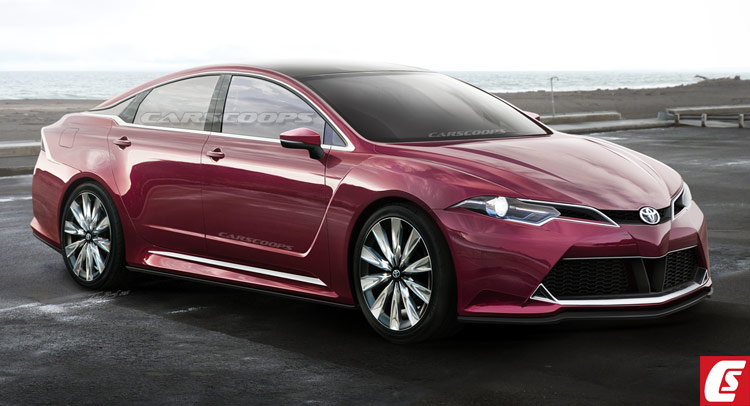When it comes to automotive white-wear on wheels, nothing else springs to mind more than the name ‘Camry’. Sure there is nothing really wrong with Toyota’s mid-size sedan offering – it does everything one expects of it; i.e. comfortable and dependable motoring.
However, it has never stirred emotions or created desire for the motoring enthusiasts out there – think of it as the McDonald’s burger of cars; it’s not terribly horrible, but not entirely great either.
The current generation car started life as a dull, three-box rolling appliance. Fortunately, a recent heavy makeover has injected some visual identity and general improvements – even if some of the execution is clumsy – that horrid black & glossy rear quarter panel springs to mind.
So how does Toyota progress from here; what if the big T decided to break the mold and challenge the better lookers among the mid-size segment? Well, let’s take an illustrated look where the next Camry could head.
For this in-house Carscoops study, styling has been inspired by recent Toyota concept cars, such as the C-HR crossover hybrid, FT-1 sports car, and NS4 Plugin Hybrid sedan. Frontal design is a mix of the aforementioned concepts, whilst still retaining cues from Camry’s past. Chrome edging spears out from the headlights, leading into the grill for a more distinctive front-end graphic.
From the aggressive spilt frontal intake, dynamism continues over the pronounced front fenders; here the Nissan GT-R-like character lines flow into the lower doors, whilst heavily channeled side sills help exude that go-fast look.
Probably the most contentious aspect of this study will likely be the greenhouse; even with its up-kick over the rear haunches, the sleek roofline does incorporate the latest annoying trend of extending the side quarter windows deep into rear pillars – albeit via a more subtle approach.
Compared to rivals like the Mazda6 and EU-market VW Passat, the Camry is a little off the pace in terms of style and perceived luxury. To remedy this, an NS4-inspired interior (albeit in more production-friendly form) with premium touches; like double-stitched leather surfaces, piano black inlays and aluminum fittings would lift interior ambience vastly.
Currently, Toyota’s mid-sizer is powered by 4-cylinder, V6 and Hybrid engines. All of which do a fairly decent job, however as with most things there could be room for improvement. Sporty looks deserve a sporty power plant and this time, Toyota’s turbocharged 2.0-litre gasoline four-pot is expected to enter the picture. A hybrid model will also be offered with a four-cylinder mill working together with an electric motor to provide low emissions and top fuel economy.
What would really make the Camry stand out, however, would be if Toyota combined the turbo four with rear axle-mounted electric motors; this could earn the Camry some driving pleasure and street credibility. Any potent hybrid powertrain would need an equally impressive chassis setup; Cue on-demand AWD, and continuously adaptive damping system – with the obligatory comfort, normal and sport modes. Ideally complimented by an intuitive electric power assisted steering setup (they are getting better), which would deliver precise turn-in and positive wheel feedback.
Other tricks that could help put Camry at the front of the pack are weight-saving applications like aluminum for the structure and body, CFRP (carbon fibre-reinforced plastic) components and improved body rigidity.
Camry’s main opposition comes from the equally staid, yet well-refined Honda Accord, whilst other players like Ford’s Fusion, Hyundai Sonata, Kia Optima, Mazda6 and Chevrolet Malibu offer a good amount of eye candy to the everyday driver.
Tell us your thoughts on where the design direction of the next Camry should head in the comments below.
By Josh Byrnes
Photo Renderings Copyright Carscoops / Josh Byrnes




